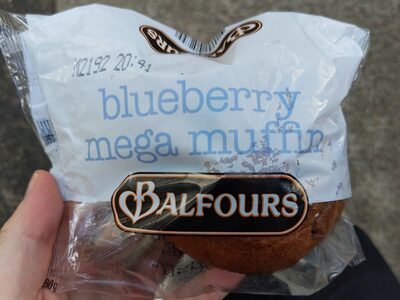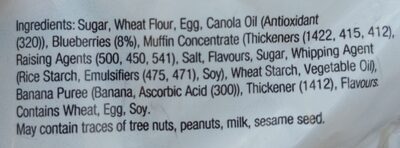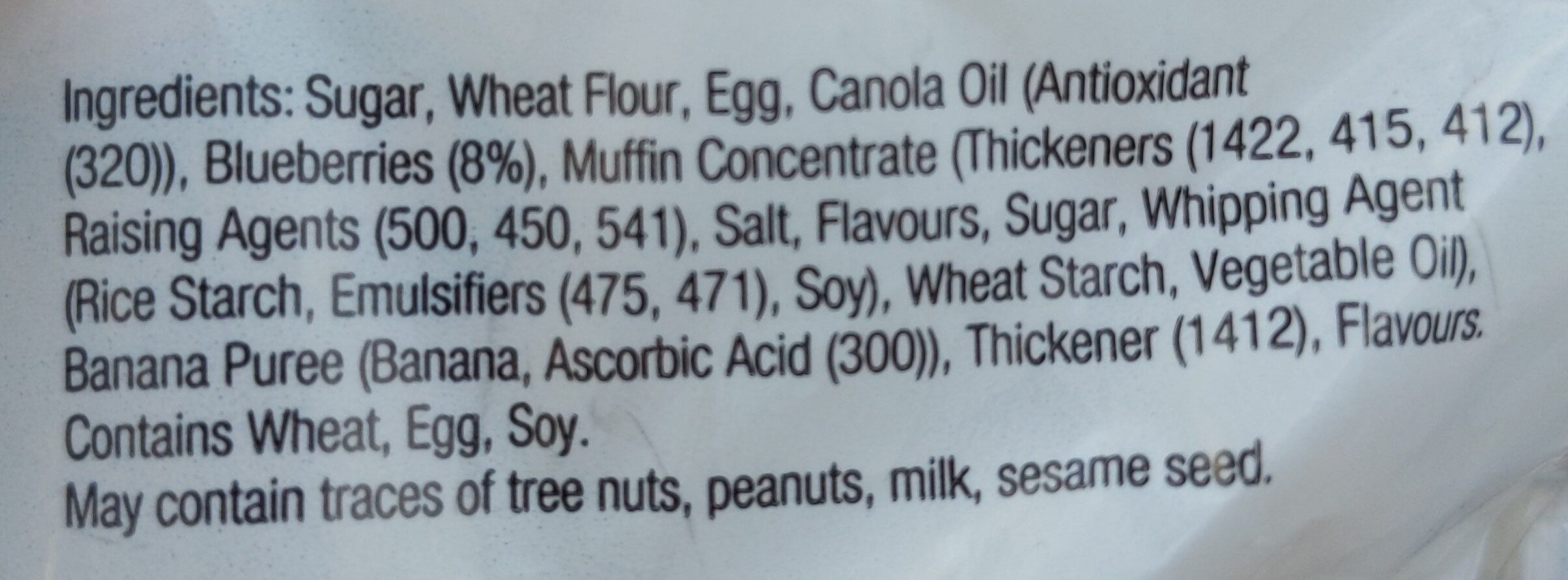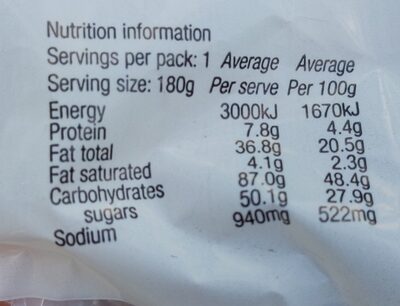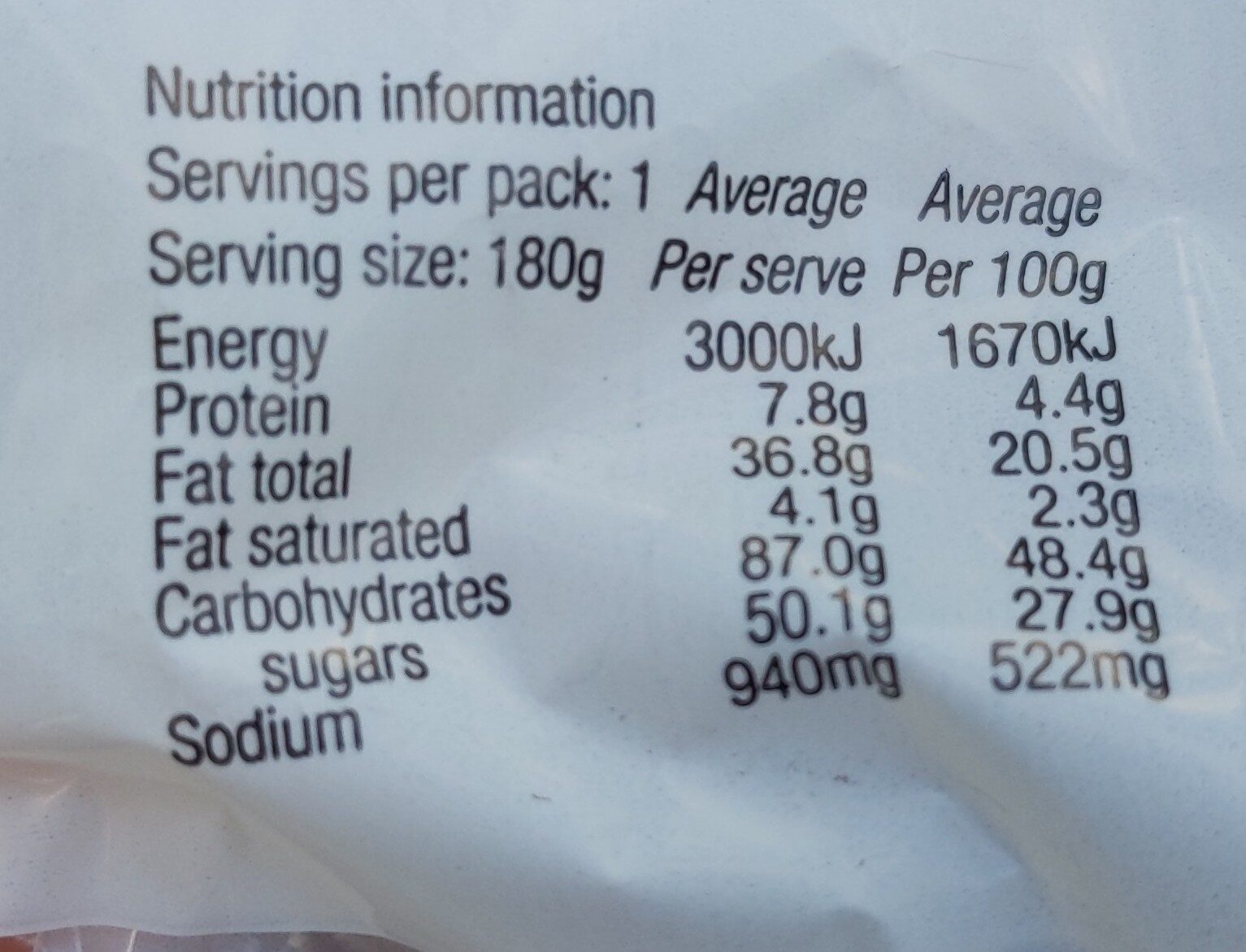Help us make food transparency the norm!
As a non-profit organization, we depend on your donations to continue informing consumers around the world about what they eat.
The food revolution starts with you!
Blueberry Mega Muffin - Balfour's
Blueberry Mega Muffin - Balfour's
This product page is not complete. You can help to complete it by editing it and adding more data from the photos we have, or by taking more photos using the app for Android or iPhone/iPad. Thank you!
×
Barcode: 9310090052799 (EAN / EAN-13)
Brands: Balfour's
Categories: Snacks, Sweet snacks, Biscuits and cakes, Cakes, Muffins, Fruit muffins, Blueberry muffins
Stores: The Fresh Basket
Countries where sold: Australia
Matching with your preferences
Health
Ingredients
-
34 ingredients
Sugar, wheat flour, egg, canola oil (antioxidant (320)), blueberries (8%), muffin concentrate (thickeners (1422, 415, 412), raising agents (500, 450, 541), salt, flavours, sugar, whipping agent (rice starch, emulsifiers (475, 471), soy), wheat starch, vegetable oil), banana puree (banana, ascorbic acid (300)), thickener (1412), flavours.Allergens: Banana, Eggs, Gluten, SoybeansTraces: Milk, Nuts, Peanuts, Sesame seeds
Food processing
-
Ultra processed foods
Elements that indicate the product is in the 4 - Ultra processed food and drink products group:
- Additive: E1412 - Distarch phosphate
- Additive: E1422 - Acetylated distarch adipate
- Additive: E412 - Guar gum
- Additive: E415 - Xanthan gum
- Additive: E450 - Diphosphates
- Additive: E471 - Mono- and diglycerides of fatty acids
- Additive: E475 - Polyglycerol esters of fatty acids
- Ingredient: Emulsifier
- Ingredient: Flavouring
- Ingredient: Thickener
Food products are classified into 4 groups according to their degree of processing:
- Unprocessed or minimally processed foods
- Processed culinary ingredients
- Processed foods
- Ultra processed foods
The determination of the group is based on the category of the product and on the ingredients it contains.
Additives
-
E1422 - Acetylated distarch adipate
Acetylated distarch adipate: Acetylated distarch adipate -E1422-, is a starch that is treated with acetic anhydride and adipic acid anhydride to resist high temperatures. It is used in foods as a bulking agent, stabilizer and a thickener. No acceptable daily intake for human consumption has been determined.Source: Wikipedia
-
E320 - Butylated hydroxyanisole (bha)
Butylated hydroxyanisole: Butylated hydroxyanisole -BHA- is an antioxidant consisting of a mixture of two isomeric organic compounds, 2-tert-butyl-4-hydroxyanisole and 3-tert-butyl-4-hydroxyanisole. It is prepared from 4-methoxyphenol and isobutylene. It is a waxy solid used as a food additive with the E number E320. The primary use for BHA is as an antioxidant and preservative in food, food packaging, animal feed, cosmetics, rubber, and petroleum products. BHA also is commonly used in medicines, such as isotretinoin, lovastatin, and simvastatin, among others.Source: Wikipedia
-
E412 - Guar gum
Guar gum (E412) is a natural food additive derived from guar beans.
This white, odorless powder is valued for its remarkable thickening and stabilizing properties, making it a common ingredient in various food products, including sauces, dressings, and ice creams.
When used in moderation, guar gum is considered safe for consumption, with no known adverse health effects.
-
E415 - Xanthan gum
Xanthan gum (E415) is a natural polysaccharide derived from fermented sugars, often used in the food industry as a thickening and stabilizing agent.
This versatile food additive enhances texture and prevents ingredient separation in a wide range of products, including salad dressings, sauces, and gluten-free baked goods.
It is considered safe for consumption even at high intake amounts.
-
E450 - Diphosphates
Diphosphates (E450) are food additives often utilized to modify the texture of products, acting as leavening agents in baking and preventing the coagulation of canned food.
These salts can stabilize whipped cream and are also found in powdered products to maintain their flow properties. They are commonly present in baked goods, processed meats, and soft drinks.
Derived from phosphoric acid, they're part of our daily phosphate intake, which often surpasses recommended levels due to the prevalence of phosphates in processed foods and drinks.
Excessive phosphate consumption is linked to health issues, such as impaired kidney function and weakened bone health. Though diphosphates are generally regarded as safe when consumed within established acceptable daily intakes, it's imperative to monitor overall phosphate consumption to maintain optimal health.
-
E471 - Mono- and diglycerides of fatty acids
Mono- and diglycerides of fatty acids (E471), are food additives commonly used as emulsifiers in various processed foods.
These compounds consist of glycerol molecules linked to one or two fatty acid chains, which help stabilize and blend water and oil-based ingredients. E471 enhances the texture and shelf life of products like margarine, baked goods, and ice cream, ensuring a smooth and consistent texture.
It is generally considered safe for consumption within established regulatory limits.
-
E500 - Sodium carbonates
Sodium carbonates (E500) are compounds commonly used in food preparation as leavening agents, helping baked goods rise by releasing carbon dioxide when they interact with acids.
Often found in baking soda, they regulate the pH of food, preventing it from becoming too acidic or too alkaline. In the culinary world, sodium carbonates can also enhance the texture and structure of foods, such as noodles, by modifying the gluten network.
Generally recognized as safe, sodium carbonates are non-toxic when consumed in typical amounts found in food.
-
E541 - Sodium aluminium phosphate
Sodium aluminium phosphate: Sodium aluminium phosphate -SAlP- describes the inorganic compounds consisting of sodium salts of aluminium phosphates. The most common SAlP has the formulas NaH14Al3-PO4-8·4H2O and Na3H15Al2-PO4-8. These materials are prepared by combining alumina, phosphoric acid, and sodium hydroxide.In addition to the usual hydrate, an anhydrous SAlP is also known, Na3H15Al2-PO4-8 -CAS#10279-59-1-, referred to as 8:2:3, reflecting the ratio of phosphate to aluminium to sodium. Additionally an SAlP of ill-defined stoichiometry is used -NaxAly-PO4-z -CAS# 7785-88-8-.The acidic sodium aluminium phosphates are used as acids for baking powders for the chemical leavening of baked goods. Upon heating, SAlP combines with the baking soda to give carbon dioxide. Most of its action occurs at baking temperatures, rather than when the dough or batter is mixed at room temperature. SAlPs are advantageous because they impart a neutral flavor. As a food additive, it has the E number E541. Basic sodium aluminium phosphates are also known, e.g., Na15Al3-PO4-8. These species are useful in cheese making.Source: Wikipedia
Ingredients analysis
-
May contain palm oil
Ingredients that may contain palm oil: Vegetable oil
-
Non-vegan
Non-vegan ingredients: EggSome ingredients could not be recognized.
We need your help!
You can help us recognize more ingredients and better analyze the list of ingredients for this product and others:
- Edit this product page to correct spelling mistakes in the ingredients list, and/or to remove ingredients in other languages and sentences that are not related to the ingredients.
- Add new entries, synonyms or translations to our multilingual lists of ingredients, ingredient processing methods, and labels.
If you would like to help, join the #ingredients channel on our Slack discussion space and/or learn about ingredients analysis on our wiki. Thank you!
-
Vegetarian status unknown
Unrecognized ingredients: 320, Muffin-concentrate, 1422, 415, 412, 500, 450, 541, 475, 471, 300, 1412Some ingredients could not be recognized.
We need your help!
You can help us recognize more ingredients and better analyze the list of ingredients for this product and others:
- Edit this product page to correct spelling mistakes in the ingredients list, and/or to remove ingredients in other languages and sentences that are not related to the ingredients.
- Add new entries, synonyms or translations to our multilingual lists of ingredients, ingredient processing methods, and labels.
If you would like to help, join the #ingredients channel on our Slack discussion space and/or learn about ingredients analysis on our wiki. Thank you!
-
Details of the analysis of the ingredients
We need your help!
Some ingredients could not be recognized.
We need your help!
You can help us recognize more ingredients and better analyze the list of ingredients for this product and others:
- Edit this product page to correct spelling mistakes in the ingredients list, and/or to remove ingredients in other languages and sentences that are not related to the ingredients.
- Add new entries, synonyms or translations to our multilingual lists of ingredients, ingredient processing methods, and labels.
If you would like to help, join the #ingredients channel on our Slack discussion space and/or learn about ingredients analysis on our wiki. Thank you!
: Sugar, wheat flour, egg, canola oil (antioxidant (320)), blueberries 8%, muffin concentrate, thickeners (1422, 415, 412), raising agents (500, 450, 541), salt, flavours, sugar, whipping agent (rice starch, emulsifiers (475, 471), soy), wheat starch, vegetable oil, banana (banana, ascorbic acid (300)), thickener (1412), flavours- Sugar -> en:sugar - vegan: yes - vegetarian: yes - ciqual_proxy_food_code: 31016 - percent_min: 8 - percent_max: 68
- wheat flour -> en:wheat-flour - vegan: yes - vegetarian: yes - ciqual_proxy_food_code: 9410 - percent_min: 8 - percent_max: 38
- egg -> en:egg - vegan: no - vegetarian: yes - ciqual_food_code: 22000 - percent_min: 8 - percent_max: 28
- canola oil -> en:canola-oil - vegan: yes - vegetarian: yes - from_palm_oil: no - percent_min: 8 - percent_max: 23
- antioxidant -> en:antioxidant - percent_min: 8 - percent_max: 23
- 320 -> en:320 - percent_min: 8 - percent_max: 23
- antioxidant -> en:antioxidant - percent_min: 8 - percent_max: 23
- blueberries -> en:blueberry - vegan: yes - vegetarian: yes - ciqual_food_code: 13028 - percent_min: 8 - percent: 8 - percent_max: 8
- muffin concentrate -> en:muffin-concentrate - percent_min: 0 - percent_max: 8
- thickeners -> en:thickener - percent_min: 0 - percent_max: 8
- 1422 -> en:1422 - percent_min: 0 - percent_max: 8
- 415 -> en:415 - percent_min: 0 - percent_max: 4
- 412 -> en:412 - percent_min: 0 - percent_max: 2.66666666666667
- raising agents -> en:raising-agent - percent_min: 0 - percent_max: 8
- 500 -> en:500 - percent_min: 0 - percent_max: 8
- 450 -> en:450 - percent_min: 0 - percent_max: 4
- 541 -> en:541 - percent_min: 0 - percent_max: 2.66666666666667
- salt -> en:salt - vegan: yes - vegetarian: yes - ciqual_food_code: 11058 - percent_min: 0 - percent_max: 1.305
- flavours -> en:flavouring - vegan: maybe - vegetarian: maybe - percent_min: 0 - percent_max: 1.305
- sugar -> en:sugar - vegan: yes - vegetarian: yes - ciqual_proxy_food_code: 31016 - percent_min: 0 - percent_max: 1.305
- whipping agent -> en:foaming-agent - percent_min: 0 - percent_max: 1.305
- rice starch -> en:rice-starch - vegan: yes - vegetarian: yes - ciqual_proxy_food_code: 9510 - percent_min: 0 - percent_max: 1.305
- emulsifiers -> en:emulsifier - percent_min: 0 - percent_max: 0.6525
- 475 -> en:475 - percent_min: 0 - percent_max: 0.6525
- 471 -> en:471 - percent_min: 0 - percent_max: 0.32625
- soy -> en:soya - vegan: yes - vegetarian: yes - percent_min: 0 - percent_max: 0.435
- wheat starch -> en:wheat-starch - vegan: yes - vegetarian: yes - ciqual_proxy_food_code: 9510 - percent_min: 0 - percent_max: 1.305
- vegetable oil -> en:vegetable-oil - vegan: yes - vegetarian: yes - from_palm_oil: maybe - percent_min: 0 - percent_max: 1.305
- banana -> en:banana - vegan: yes - vegetarian: yes - ciqual_food_code: 13005 - percent_min: 0 - percent_max: 1.305
- banana -> en:banana - vegan: yes - vegetarian: yes - ciqual_food_code: 13005 - percent_min: 0 - percent_max: 1.305
- ascorbic acid -> en:e300 - vegan: yes - vegetarian: yes - percent_min: 0 - percent_max: 0.6525
- 300 -> en:300 - percent_min: 0 - percent_max: 0.6525
- thickener -> en:thickener - percent_min: 0 - percent_max: 1.305
- 1412 -> en:1412 - percent_min: 0 - percent_max: 1.305
- flavours -> en:flavouring - vegan: maybe - vegetarian: maybe - percent_min: 0 - percent_max: 1.305
Nutrition
-
Poor nutritional quality
⚠ ️Warning: the amount of fiber is not specified, their possible positive contribution to the grade could not be taken into account.⚠ ️Warning: the amount of fruits, vegetables and nuts is not specified on the label, it was estimated from the list of ingredients: 22This product is not considered a beverage for the calculation of the Nutri-Score.
Positive points: 0
- Proteins: 2 / 5 (value: 4.4, rounded value: 4.4)
- Fiber: 0 / 5 (value: 0, rounded value: 0)
- Fruits, vegetables, nuts, and colza/walnut/olive oils: 0 / 5 (value: 22.5, rounded value: 22.5)
Negative points: 17
- Energy: 4 / 10 (value: 1670, rounded value: 1670)
- Sugars: 6 / 10 (value: 27.9, rounded value: 27.9)
- Saturated fat: 2 / 10 (value: 2.3, rounded value: 2.3)
- Sodium: 5 / 10 (value: 522, rounded value: 522)
The points for proteins are not counted because the negative points are greater or equal to 11.
Nutritional score: (17 - 0)
Nutri-Score:
-
Nutrient levels
-
Fat in high quantity (20.5%)
What you need to know- A high consumption of fat, especially saturated fats, can raise cholesterol, which increases the risk of heart diseases.
Recommendation: Limit the consumption of fat and saturated fat- Choose products with lower fat and saturated fat content.
-
Saturated fat in moderate quantity (2.3%)
What you need to know- A high consumption of fat, especially saturated fats, can raise cholesterol, which increases the risk of heart diseases.
Recommendation: Limit the consumption of fat and saturated fat- Choose products with lower fat and saturated fat content.
-
Sugars in high quantity (27.9%)
What you need to know- A high consumption of sugar can cause weight gain and tooth decay. It also augments the risk of type 2 diabetes and cardio-vascular diseases.
Recommendation: Limit the consumption of sugar and sugary drinks- Sugary drinks (such as sodas, fruit beverages, and fruit juices and nectars) should be limited as much as possible (no more than 1 glass a day).
- Choose products with lower sugar content and reduce the consumption of products with added sugars.
-
Salt in moderate quantity (1.3%)
What you need to know- A high consumption of salt (or sodium) can cause raised blood pressure, which can increase the risk of heart disease and stroke.
- Many people who have high blood pressure do not know it, as there are often no symptoms.
- Most people consume too much salt (on average 9 to 12 grams per day), around twice the recommended maximum level of intake.
Recommendation: Limit the consumption of salt and salted food- Reduce the quantity of salt used when cooking, and don't salt again at the table.
- Limit the consumption of salty snacks and choose products with lower salt content.
-
-
Nutrition facts
Nutrition facts As sold
for 100 g / 100 mlCompared to: Blueberry muffins Energy 1,670 kj
(399 kcal)+12% Fat 20.5 g +24% Saturated fat 2.3 g -14% Carbohydrates 48.4 g +1% Sugars 27.9 g +15% Fiber ? Proteins 4.4 g -14% Salt 1.305 g +80% Alcohol 0 % vol Fruits‚ vegetables‚ nuts and rapeseed‚ walnut and olive oils (estimate from ingredients list analysis) 22.5 %
Environment
-
Eco-Score C - Moderate environmental impact
⚠ ️Select a country in order to include the full impact of transportation.The Eco-Score is an experimental score that summarizes the environmental impacts of food products.→ The Eco-Score was initially developped for France and it is being extended to other European countries. The Eco-Score formula is subject to change as it is regularly improved to make it more precise and better suited to each country.Life cycle analysis
-
Average impact of products of the same category: B (Score: 68/100)
Category: Muffin, with blueberry or chocolate
Category: Muffin, with blueberry or chocolate
- PEF environmental score: 0.36 (the lower the score, the lower the impact)
- including impact on climate change: 4.24 kg CO2 eq/kg of product
Stage Impact Agriculture
53.0 %Processing
36.9 %Packaging
5.3 %Transportation
3.5 %Distribution
1.4 %Consumption
0.0 %
Bonuses and maluses
-
Missing origins of ingredients information
Malus: -5
⚠ ️ The origins of the ingredients of this product are not indicated.
If they are indicated on the packaging, you can modify the product sheet and add them.
If you are the manufacturer of this product, you can send us the information with our free platform for producers.
-
Missing packaging information for this product
Malus: -15
⚠ ️ The information about the packaging of this product is not filled in.⚠ ️ For a more precise calculation of the Eco-Score, you can modify the product page and add them.
If you are the manufacturer of this product, you can send us the information with our free platform for producers.
Eco-Score for this product
-
Impact for this product: C (Score: 48/100)
Product: Blueberry Mega Muffin - Balfour's
Life cycle analysis score: 68
Sum of bonuses and maluses: -20
Final score: 48/100
-
Carbon footprint
-
Equal to driving 2.2 km in a petrol car
424 g CO² per 100g of product
The carbon emission figure comes from ADEME's Agribalyse database, for the category: Muffin, with blueberry or chocolate (Source: ADEME Agribalyse Database)
Stage Impact Agriculture
37.4 %Processing
51.9 %Packaging
6.8 %Transportation
3.4 %Distribution
0.5 %Consumption
0.0 %
Packaging
-
Missing packaging information for this product
⚠ ️ The information about the packaging of this product is not filled in.Take a photo of the recycling information Take a photo of the recycling information
Transportation
-
Origins of ingredients
Missing origins of ingredients information
⚠ ️ The origins of the ingredients of this product are not indicated.
If they are indicated on the packaging, you can modify the product sheet and add them.
If you are the manufacturer of this product, you can send us the information with our free platform for producers.Add the origins of ingredients for this product Add the origins of ingredients for this product
Report a problem
-
Incomplete or incorrect information?
Category, labels, ingredients, allergens, nutritional information, photos etc.
If the information does not match the information on the packaging, please complete or correct it. Open Food Facts is a collaborative database, and every contribution is useful for all.
